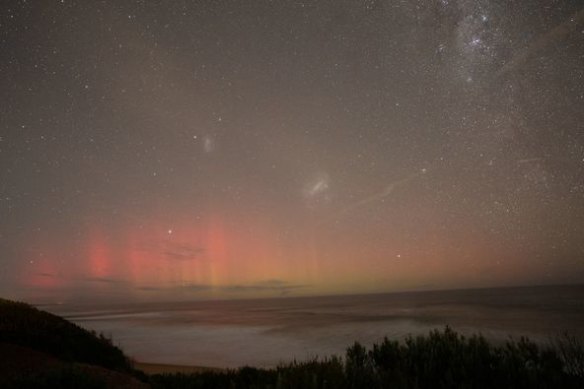This was published 8 months ago
Dazzling aurora australis light show possible in Victoria tonight
Victorian stargazers are hoping for a dazzling winter light show as astronomers predict the aurora australis might be visible off Australia’s southern coast on Wednesday night.
The Bureau of Meteorology’s Australian Space Weather Forecasting Centre issued an aurora watch on Wednesday because “several coronal mass ejections” from the sun could trigger a geomagnetic storm above Earth.
“If geomagnetic activity does eventuate, aurora may be visible during local nighttime hours in Tasmania and southern Victoria on July 31,” the notice said.
Monash University astronomer Michael Brown said a similar event in May was “absolutely spectacular” – possibly one of the best in centuries.
“It’s unlikely that we’re going to be rewarded with something that good again,” he said. “But it’s still possible to see perfectly good auroras.”
Brown said astronomers could roughly predict a few days in advance if particles ejected from the sun might cause the mesmerising hues of green, pink, red and yellow light. But he cautioned that such estimates were inexact.

Aurora lights pictured about 8pm on Tuesday at Kilcunda, near Phillip Island.Credit: Glenn Smith
“It’s a little bit fickle. The arrival time is uncertain by quite a lot of hours,” Brown said. “How those particles translate to visible aurora is always a little bit uncertain too.”
But there was a decent chance something would be seen on Wednesday night, he said.
On Tuesday night, aurora lights were spotted in parts of Victoria and Tasmania.
In May, an extreme geomagnetic storm – rated the maximum “G5″ on the US National Oceanic Atmospheric Administration’s space weather scale – caused bright auroras to be seen as far north as Western Australia’s Pilbara region, the weather bureau said.
The bureau predicted that Wednesday night would bring “G1-G2 geomagnetic storming with a slight chance for G3”.
Brown, an associate professor at Monash University’s School of Physics and Astronomy, recommended those who want the best chance to see an aurora on Wednesday head to the clear dark skies of country Victoria – away from suburban lights – with a good view of the southern horizon.
He also suggested monitoring social media sites such as the Aurora Hunters Victoria Facebook group for posts about where the colourful lights could be seen.
Brown said the sun was now near the peak of a natural cycle of activity that spanned about 11 years. That meant it was emitting more of the solar flares and particles that caused auroras.
“So that means that people are seeing more aurora this year than they have seen in a decade or two,” he said.
“And this solar cycle is much more active than the previous one, so we’re getting more aurora this time around than we did roughly 11 years ago.”
Clouds could obscure some views of the night sky, but the weather bureau’s forecast suggested recent foggy conditions were not expected to be an issue.
Our Breaking News Alert will notify you of significant breaking news when it happens. Get it here.